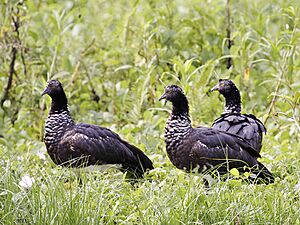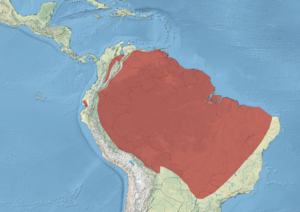Horned screamer facts for kids
Quick facts for kids Horned screamer |
|
|---|---|
 |
|
| Three in Manu National Park, Peru | |
| Conservation status | |
| Scientific classification | |
| Genus: |
Anhima
|
| Species: |
cornuta
|
 |
|
| Distribution map | |
| Synonyms | |
|
Palamedea cornuta Linnaeus, 1766 |
|
The horned screamer (Anhima cornuta) is a type of bird that lives in wet areas (wetlands) in tropical South America. It is part of a small bird family called Anhimidae. There are three kinds of screamers, and the other two are the southern screamer and the northern screamer. These birds are related to ducks, geese, and swans, but their beaks look more like those of game birds (like chickens).
Contents
What is a Horned Screamer?
The horned screamer is a very large bird, usually about 84 to 95 centimeters (33 to 37 inches) long. It weighs around 3.5 kilograms (7.7 pounds). It has a small beak that looks a bit like a chicken's. Its head, upper body, and chest are black, with small white spots on its head, throat, and wing feathers.
Why is it called "horned"?
This bird gets its name from a long, spiky growth that sticks out from the top of its head. This "horn" is special because it's not a feather. It's a hard, bony structure that grows all the time, even though its tip often breaks off.
What does a Horned Screamer look like?
Horned screamers have very long, thin legs and three large toes on each foot. Their belly and the feathers under their wings are white. They also have two sharp spurs (like small spikes) on each wing. Their feet are only partly webbed, which means the skin between their toes doesn't go all the way to the end.
Where do Horned Screamers Live?
Horned screamers are found in low-lying areas across many South American countries. These include Colombia, Venezuela, Brazil, Bolivia, Peru, Ecuador, French Guiana, Suriname, and Guyana. They might have disappeared from Trinidad. Even though their numbers have gone down in some places, they are still common in many areas. In Brazil, their living area seems to have grown recently.
What kind of places do they prefer?
These birds live in marshes and other wet areas that have a lot of plants. They like places where they can find plenty of water plants to eat.
How do Horned Screamers Behave?
Screamers often gather in groups, but they are not always very social. They tend to stay in one place and don't move around much. They spend their time in their marshy homes, looking for food.
Horned Screamer Sounds
As their name suggests, horned screamers make a very loud, echoing sound. People in Ecuador call this sound "el clon-clon" because of how it sounds.
Reproduction and Life Cycle
When it's time to lay eggs, the horned screamer builds a large nest. This nest is made of floating plants and is held in place in shallow water. The female lays three olive-brown eggs. Just like most Anseriformes (the group that includes ducks and geese), the young chicks can run around as soon as they hatch.
Horned Screamer as a Symbol
The horned screamer is an important bird in some parts of South America. It is the official bird of the Department of Arauca and the Municipality of Arauca in Colombia. It is also a symbol for the National Reserve of Churute in Ecuador. The department and its main city in Colombia are actually named after this bird, which is called arauco or aruco in Spanish.


